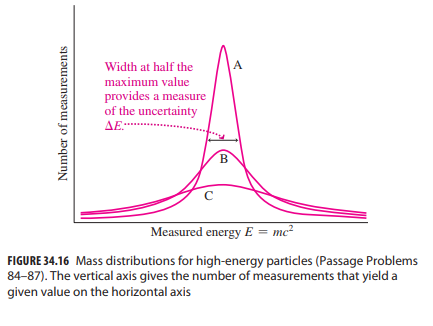Particle physicists use the energytime uncertainty relation to estimate the lifetimes of unstable particles produced in high-energy
Question:
Particle physicists use the energy–time uncertainty relation to estimate the lifetimes of unstable particles produced in high-energy particle accelerators (Chapter 39). Some particles have lifetimes of 10-24 s and shorter—impossible to measure directly. However, physicists can measure particle masses, and they do so for many instances of the same particle to get a distribution of masses. By Einstein’s E = mc2 , that corresponds to a distribution of energies (Fig. 34.16). Measuring the distribution’s width at half its peak (see Fig. 34.16) gives an estimate of the energy uncertainty, and the corresponding ∆t from inequality 34.16 provides the particle’s lifetime.

The converse approach is used for particles with longer lifetimes: Direct measurement of the lifetime yields, through energy–time uncertainty, a range of expected values for particle energies or masses. The longer the lifetime,
a. the wider the mass range and the narrower the energy range.
b. the wider the mass and energy ranges.
c. the narrower the mass range and the wider the energy range.
d. the narrower the mass and energy ranges.
Step by Step Answer:






